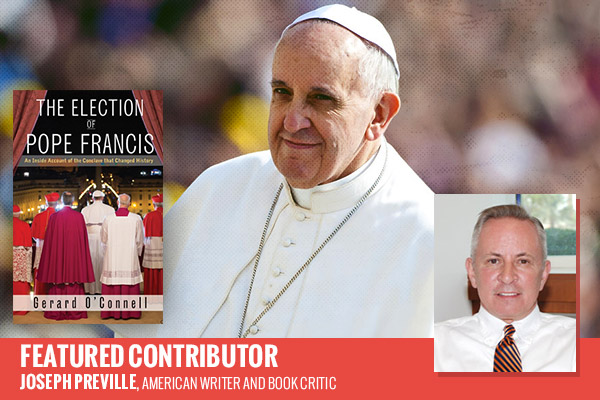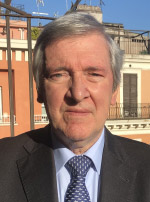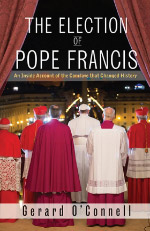
How Pope Francis was Selected to Lead the Catholic Church: An Interview with Gerard O’Connell
- By Joseph Preville --
- 10 Jul 2019 --

How Pope Francis was chosen, the problems he inherited from Benedict XVI, and how Francis represents “a number of firsts.”
The election of Pope Francis on March 13, 2013 was a pivotal moment in the history of the Catholic Church. Gerard O’Connell takes us on a guided tour of this momentous event in The Election of Pope Francis: An Inside Account of the Conclave the Changed History (Orbis Books, 2019). O’Connell is a noted journalist and Vatican correspondent for America, the weekly magazine published by the Jesuits of the United States. He is the author of Do Not Stifle the Spirit: Conversations with Jacques Dupuis (Orbis Books, 2017). O’Connell’s account of the 2013 Conclave of Cardinals is based on meticulous research and first-hand information from knowledgeable, and, in many cases, confidential sources inside and outside of the Vatican. What O’Connell has produced is a rare and fascinating glimpse into the mysterious process of how Pope Francis was selected to lead the Catholic Church and its 1.3 billion members in the world today.
How Pope Francis was Selected to Lead the Catholic Church: An Interview with Gerard O’Connell[/tweetthis]
Gerard O’Connell discusses his new book in this interview.
Joseph Richard Preville: Why do you think the election of Pope Francis (Cardinal Jorge Mario Bergoglio of Argentina) on March 13, 2013 was applauded around the world by Catholics and non-Catholics alike?
 Gerard O’Connell: From the moment Francis appeared on the central balcony of St. Peter’s Basilica to greet people for the first time as pope, everyone could see that the Catholic Church had a very different kind of leader, a man of great humility, a man of God who uses simple words and powerful gestures to reach people’s hearts.
Gerard O’Connell: From the moment Francis appeared on the central balcony of St. Peter’s Basilica to greet people for the first time as pope, everyone could see that the Catholic Church had a very different kind of leader, a man of great humility, a man of God who uses simple words and powerful gestures to reach people’s hearts.
GO: He reached their hearts immediately with his simple greeting, “Brothers and sisters, Good evening!” He made them laugh by saying the cardinals went “to the ends of the world” to find the new bishop of Rome. He moved them to tears by inviting them to pray for his predecessor, Benedict XVI, and reciting the prayers every Catholic knows: Our Father, Hail Mary, Glory be to the Father. Then before imparting his blessing, Francis asked the faithful in St Peter’s Square to pray for God’s blessing on him, and then stunned everybody by bowing down before them as they prayed. No pope has ever done this.
JRP: How did the election of Pope Francis represent “a number of firsts”?
GO: Francis is the first pope ever from the southern hemisphere, the first from the Americas, the first from Latin America where almost half of the world’s Catholics live, and the first Jesuit pope. Hitherto almost all the popes have been European, and the vast majority of them Italian, with a small number from north Africa. Furthermore, he is the first of the 265 successors of St. Peter to choose the name Francis, a name that encapsulates his program as pope.
JRP: Why did Pope Francis choose to be named after Saint Francis of Assisi?
GO: He explained why he chose that name, on March 16, when he greeted the 6000 members of the international media who had covered the conclave. He revealed that on reaching the two-thirds of the votes needed for election, the Brazilian cardinal, Claudio Hummes, who was sitting next to him, gave him a hug and a kiss and said, “Don’t forget the poor.” Pope Francis told reporters: “those words came to me: the poor, the poor. Then right away, thinking of the poor, I thought of Francis of Assisi. Then I thought of all the wars… Francis is also a man of peace. That is how the name came into my heart: Francis of Assisi. For me, he is the man of poverty, the man of peace, the man who loves and protects creation…He is the man who gives us this spirit of peace, the poor man.”
(Pope Francis then added: “How I would like a church which is poor and for the poor!”)
JRP: What critical problems facing the Catholic Church did Pope Francis inherit from his predecessor, Pope Benedict XVI, who resigned on February 28, 2013?
GO: The Catholic Church faced many problems at the time of Benedict XVI’s resignation. There were problems in the central government of the church, in the Vatican; leaked documents revealed infighting; there were scandals, both financial and sexual abuse of minors by clergy; the situation seemed out of control. Then the Catholic Church in Europe was in visible decline, while in Latin America many Catholics were joining the evangelicals or Pentecostals. There was concern at the ever-decreasing Catholic population in the Holy Land and throughout the Middle East, and at the difficult situation of the Church in China, as well as religious persecution in many countries. Furthermore, the dialogue between Catholics and the followers of other religions, especially Islam, was in a difficult moment, and this endangered peace and harmony in the world. There were other grave problems too, linked to poverty, armed conflicts, religious intolerance that were forcing people to migrate.
 JRP: You note that Cardinal Jorge Mario Bergoglio received 85 out of the final 115 votes cast in the 2013 Conclave of Cardinals. What do you believe were the factors or reasons that influenced more than two-thirds of the Cardinals to vote in his favor?
JRP: You note that Cardinal Jorge Mario Bergoglio received 85 out of the final 115 votes cast in the 2013 Conclave of Cardinals. What do you believe were the factors or reasons that influenced more than two-thirds of the Cardinals to vote in his favor?
GO: They saw in him a deeply spiritual leader, “a man of God”, a humble, authentic believer who lived a simple life, a man without ambition, who shunned the status symbols of power and had great love for the poor. They saw that he was first and foremost a pastor, with long experience of governing a major diocese. They heard him give a brief, inspiring speech in the plenary assembly of cardinals (general congregations) on the eve of the conclave which revealed that he is a leader with a vision, a good communicator, capable of touching hearts. They saw then that he was quite different from the other candidates; he was inspiring, refreshing, missionary, a church leader who was looking out to the world, not inward-looking. Furthermore, 68 of the 115 electors had participated in the 2005 conclave that elected Benedict XVI and knew he was the runner-up then.
JRP: What were some of the early signs that Pope Francis would have “a new style of Papacy”?
GO: There were many. Immediately after his election, he opted to keep the simple, silver cross that he wore as bishop, rejecting the gold one that was offered to him. He insisted on wearing his old black shoes that he used to walk the streets and slums of Buenos Aires, and not exchange them for the red ones specially made for the new pope. He refused to use the papal limousine, opting instead for a small economy car. He declined to live in the papal apartment of the Apostolic Palace and chose instead to reside in a small apartment in Santa Marta, the Vatican guesthouse. He refused to sit on a chair on a raised dais when meeting leaders of the other Christian churches or of other religions, preferring instead to sit at their same level. He made the poor a priority of his pontificate and invited the Buenos Aires garbage pickers’ leader to his inauguration, giving him a front row seat.
JRP: What did the election of Pope Francis mean to you personally? Did you feel you were a witness to a historic moment in the Catholic Church?
GO: As I wrote in my book, it has been a most extraordinary experience to cover the conclave and to track the path to the papacy of the man that my family and I know so well, and love. It is difficult to describe the emotions I felt when I heard the senior cardinal deacon announce that Cardinal Jorge Mario Bergoglio was elected pope. I understood that his election represented a seismic change in the history of the Catholic Church, and I rejoiced at this. I knew that the world would soon see a very different style of papacy, given that he described himself as bishop of Rome rather than pope; it would discover that the cardinals in conclave had chosen a deeply holy man, a fearless pastor and prophet who uses gestures as much as words, to lead the Catholic church in the 21st century.


















